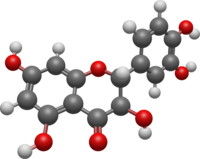Taxifolin

| |

| |
| Names | |
|---|---|
| IUPAC name
(2R,3R)-3,3′,4′,5,7-Pentahydroxyflavan-4-one
| |
| Systematic IUPAC name
(2R,3R)-2-(3,4-Dihydroxyphenyl)-3,5,7-trihydroxy-2,3-dihydro-4H-1-benzopyran-4-one | |
| Other names
Dihydroquercetin
Taxifoliol Distylin (+)-Taxifolin trans-Dihydroquercetin (+)-Dihydroquercetin | |
| Identifiers | |
3D model (
JSmol ) |
|
| ChEBI | |
| ChEMBL | |
| ChemSpider | |
ECHA InfoCard
|
100.006.859 |
| EC Number |
|
| KEGG | |
PubChem CID
|
|
| UNII | |
CompTox Dashboard (EPA)
|
|
| |
| |
| Properties | |
| C15H12O7 | |
| Molar mass | 304.254 g·mol−1 |
| Appearance | Brown powder |
| Melting point | 237 °C (459 °F; 510 K)[1] |
| UV-vis (λmax) | 290, 327 nm (methanol) |
Except where otherwise noted, data are given for materials in their standard state (at 25 °C [77 °F], 100 kPa).
| |
Taxifolin (5,7,3',4'-flavan-on-ol), also known as dihydroquercetin, belongs to the subclass flavanonols in the flavonoids, which in turn is a class of polyphenols. It is extracted from plants such as Siberian larch and milk thistle. [2]
Stereocenters
Taxifolin has two stereocenters on the C-ring, as opposed to quercetin which has none.[3] For example, (+)-taxifolin has (2R,3R)-configuration, making it 1 out of 4 stereoisomers that comprise 2 pairs of enantiomers.[4]
Natural occurrences
Taxifolin is found in non-glutinous rice boiled with adzuki bean (adzuki-meshi).[5]
It can be found in conifers like the
It is also found in the
Taxifolin is present in vinegars aged in cherry wood.[8]
Taxifolin, and flavonoids in general, can be found in many beverages and products. Specifically, taxifolin is found in plant-based foods like fruit, vegetables, wine, tea, and cocoa.[9]
Pharmacology
Taxifolin is not
Taxifolin has shown to have anti-proliferative effects on many types of cancer cells by inhibiting cancer cell lipogenesis. By inhibiting the fatty acid synthase in cancer cells, taxifolin is able to prevent the growth and spread of cancer cells.[15]
Taxifolin also stops the effects of overexpression of P-glycoprotein, which prevents the development of chemoresistance. Taxifolin does this via inhibition of rhodamine 123 and doxorubicin.[16]
The capacity of taxifolin to stimulate fibril formation and promote stabilization of fibrillar forms of
Taxifolin also enhances the efficacy of conventional
Taxifolin can act as an anti-flammant because of its ability to inhibit the synthesis of cyclooxygenase by blocking prostaglandin synthesis. [19] Indeed, the taxifolin-mediated inhibition of the E2 prostaglandin synthesis (by PLA2 phospholipase) was shown to prevent beta-amyloid-induced impairment of synapsis genesis and related memory deficits, which take part in the pathogenesis of neurodegenerative disorders like Alzheimer's disease.[20] Other observed benefits comprise the reduction of beta-amyloid accumulation in the brain vessels, restoration of vascular integrity and memory improvement in cerebral amyloid angiopathy, a condition often linked to alzheimer's.[21] Cognitive performance has even been raised in young healthy adults by taxifolin administration.[22]
Like other flavonoids, taxifolin is able to function as an antifungal agent by blocking multiple pathways that promote the growth and proliferation of fungi. [19]
Taxifolin has also been found to reduce inhibitor of intestinal mobility especially when antagonized by verapamil.[19]
Taxifolin has also been shown to be anti-hyperlipidemic by maintaining the normal lipid profile of the liver and keeping lipid excretion at normal levels. Taxifolin prevents hyperlipidemia by reducing the esterification of cellular cholesterol, phospholipid, and triacylglycerol synthesis.[16]
Taxifolin, as well as many other flavonoids, has been found to act as a non-selective
Taxifolin has been found to act as an agonist of the adiponectin receptor 2 (AdipoR2).[25]
Metabolism
The enzyme
The enzyme
Glycosides
Taxifolin 3-O-glucoside isomers have been separated from Chamaecyparis obtusa.[27]
(-)-2,3-trans-Dihydroquercetin-3'-O-β-D-glucopyranoside, a taxifolin glucoside has been extracted from the inner bark of Pinus densiflora and can act as an oviposition stimulant in the cerambycid beetle Monochamus alternatus.[28]
(2S,3S)-(-)-Taxifolin-3-O-β-D-glucopyranoside has been isolated from the root-sprouts of Agrimonia pilosa.[29]
(2R,3R)-Taxifolin-3'-O-β-D-pyranoglucoside has been isolated from the rhizome of Smilax glabra.[30]
Minor amount of taxifolin 4′-O-β-glucopyranoiside can be found in red onions.[31]
(2R,3R)-Taxifolin 3-O-
Derived natural compounds
- Dihydroquercetin-3-O-rhamnoside (Astilbin)
- (+)-Leucocyanidin can be synthesized from taxifolin by sodium borohydride reduction.[33]
References
- .
- ^ Title = Global Taxifolin Market Size was USD 167.90 Million in 2022| URL = https://www.reportprime.com/taxifolin-r195 | Date = 14 August 2023 | Website = https://www.reportprime.com/
- ^ "Quercetin". pubchem.ncbi.nlm.nih.gov.
- ^ "(+)-taxifolin (CHEBI:17948)". www.ebi.ac.uk.
- .
- ^ S2CID 97003177.
- .
- .
- PMID 15533929.
- S2CID 25826873.
- PMID 17541156.
- S2CID 43576449.
- S2CID 43576449.
- PMID 21086652.
- PMID 15533929.
- ^ a b Das, A.; Baidya, R.; Chakraborty, T.; Samanta, A. K.; Roy, S. Pharmacological basis and new insights of taxifolin: A comprehensive review. Biomedicine & Pharmacotherapy 2021, 142, 17.
- S2CID 22328651.
- PMID 21466953.
- ^ a b c Saftar Asmi, K., et al. “Therapeutic Aspects of Taxifolin – An Update.” Therapeutic Aspects of Taxifolin – An Update - Journal of Advanced Pharmacy Education and Research, SPER Publications and Solutions Pvt. Ltd., 2017, https://japer.in/article/therapeutic-aspects-of-taxifolin-an-update .
- ^ Wang (2018). "Taxifolin".
{{cite journal}}: Cite journal requires|journal=(help) - ^ Saito, 2017
- ^ Shinozaki, 2023
- PMID 17685652.
- S2CID 198131999.
- PMID 23691032.
- S2CID 94388806.
- S2CID 28973885.
- .
- PMID 2281787.
- PMID 15575206.
- .
- PMID 16454472.
- S2CID 20854538.
